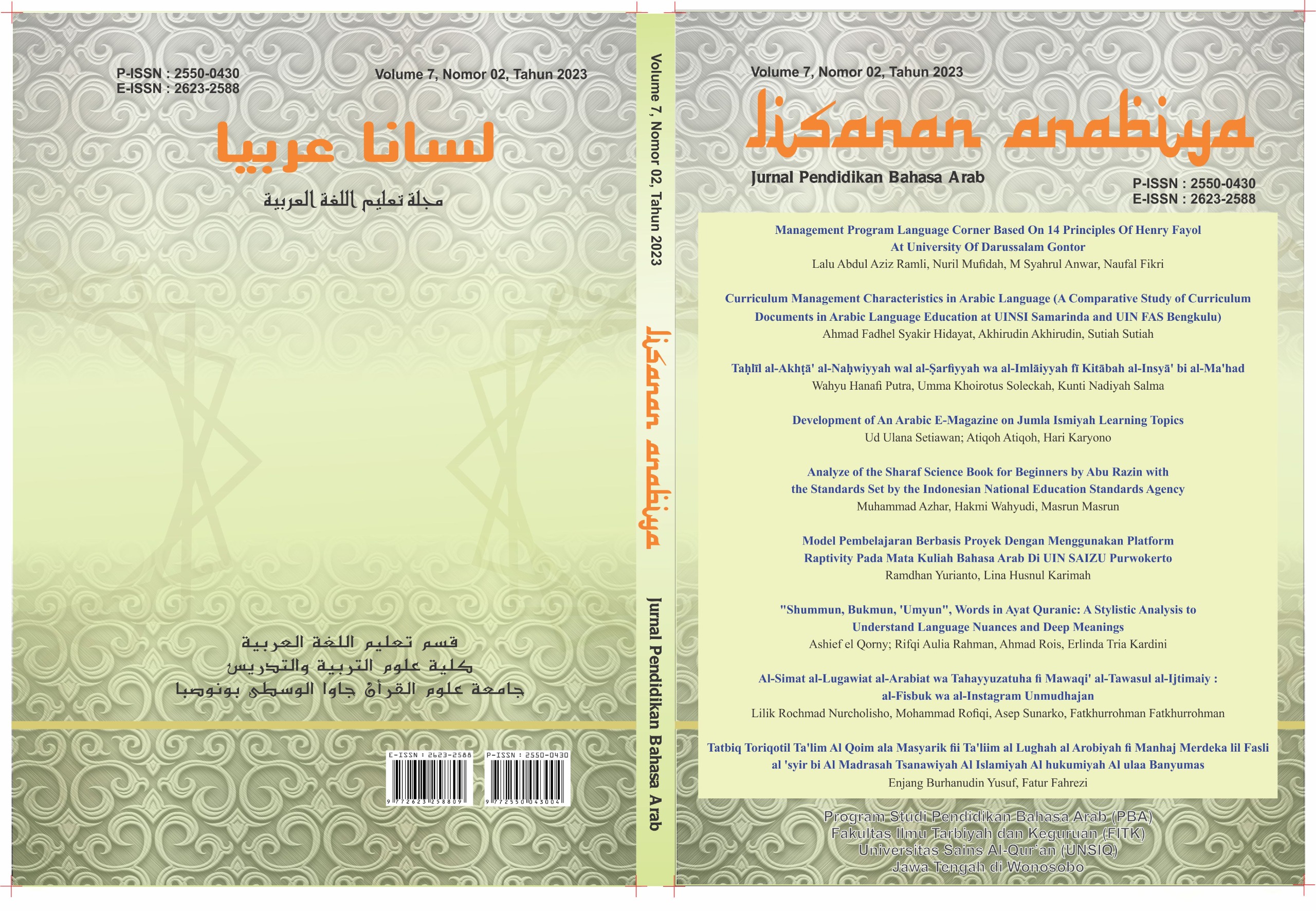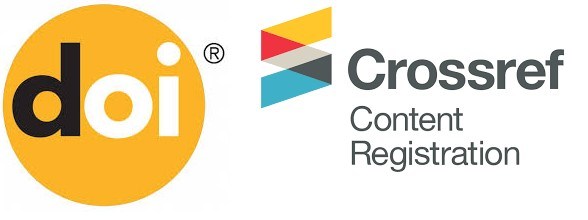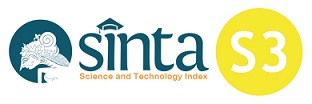Tahlil Kitab Ilmi al-Shorfi Allafahu Abu Razin wa Ummu Razin Bi Ma’ayir at-Ta’lim al-Wathaniyah al-Indonisiyah
DOI:
https://doi.org/10.32699/liar.v7i2.5681Keywords:
Analyze, BSNP, Morphology Learning, Shorof Science, TextbookAbstract
To get a decent and quality textbook, it is necessary to evaluate and analyze the book, where a quality book will help achieve learning objectives. The purpose of this research is to analyze 3rd edition of the book Shorof science for beginners by Abu Razin published by the Bisa Learning Center third edition, whether the textbook meets BSNP standards based on aspects of material, presentation, language and graphics and whether the book is suitable for beginners. The type of research used is qualitative and bibliographic research which aims to analyze more deeply the book Shorof Science for Beginners by Abu Razin. The method used is documentation study and literature study. Based on the research results, the Shorof science textbook for beginners by Abu Razin is a book that meets BSNP standards and meets the quality of teaching materials based on aspects of material, presentation, language and graphics and is very suitable for use for teaching Shorof science for beginners. The weakness of this book is that there is no Glossary and Summary at the end of the discussion chapter.
References
Afifuddin, H., & Saebani, B. A. (2012). Metode Penelitian Kualitatif, CV. Pustaka Setia: Bandung.
Ahmadi, A., & Derakhshan, A. (2016). EFL Teachers’ Perceptions towards Textbook Evaluation. Theory and Practice in Language Studies, 6(2), 260. https://doi.org/10.17507/tpls.0602.06
Al-Fauzan, A. (2010). Idhoat; Li Muallimi Al-Lughah Al-Arabiyyah Lighoiri An-Natiqina Biha.
Al-ghulayaini, M. (2010). Jamiud Durus al-Arabiyyah. Dar at-Taufiqiyyah.
Al Darwish, S. H. (2014). Teachers’ perceptions on authentic materials in language teaching in Kuwait. Journal of Education and Practice, 5(18), 119–124.
Azhar, M. (2023). Evaluasi Buku Ilmu Sharaf Untuk Pemula Karya Abu Razin dan Ummi Razin dengan Standar yang ditetapkan oleh Badan Standar Nasional Pendidikan (BSNP) Indonesia. Universitas Islam Negeri Sultan Saryif Kasim Riau.
Azhar, M., Wahyudi, H., Karim, P., & Pamil, J. (2022). Arabic Language Learning Progress in Darussakinah Batu Bersurat Islamic Boarding School. Lisanan Arabiya: Jurnal Pendidikan Bahasa Arab, 6(2), 285–307.
Azhar, M., Wahyudi, H., & Promadi, P. (2022). Arabic Language Learning with Communicative Method and Factors Affecting Student’s Speaking Ability. Takuana: Jurnal Pendidikan, Sains, Dan Humaniora, 1(2), 92–101. https://doi.org/10.56113/takuana.v1i2.33
Bano, S., Laghari, A., & Kakepoto, I. (2022). Physical Attributes and Course Contents of English Textbook (Prose II) Taught At Intermediate Level in Sindh Pakistan. The Discourse, 8(2), 27–40.
Butzkamm, W. (2003). We only learn language once. The role of the mother tongue in FL classrooms: death of a dogma. The Language Learning Journal, 28(1), 29–39. https://doi.org/10.1080/09571730385200181
Cahyani, M., Sunarko, A., Mulyani, P. S., & Fatkhurrohman, F. (2023). Telaah Komprehensif Penyajian Materi Dan Teknik Evaluasi Buku Teks Bahasa Arab Kelas VIII Madrasah Tsanawiyah KMA Nomor 183 Terbitan Kemenag Tahun 2020. Lisanan Arabiya: Jurnal Pendidikan Bahasa Arab, 7(1), 1–17.
Dabat, Z. A. (2015). Analyzing" Our Arabic language Textbooks" of the Last Grade of Primary Stage with Reference to Bloom’s Taxonomy of the Cognitive Objectives. International Journal of Academic Research in Progressive Education and Development, 4(2), 86–104.
Daud, S. (2018). Analysis of History Materials of Teaching Book History of Islamic Culture in Islamic Senior High School. Jurnal Al Bayan: Jurnal Jurusan Pendidikan Bahasa Arab, 10(2), 80. https://doi.org/10.24042/albayan.v10i2.3419
Erlina, E. (2015). Telaah Buku Ajar Pengajaran Bahasa Arab di PTAIN. Jurnal Al Bayan: Jurnal Jurusan Pendidikan Bahasa Arab, 7(2), 28–46.
Hadar, L. L. (2017). Opportunities to learn: Mathematics textbooks and students’ achievements. Studies in Educational Evaluation, 55, 153–166. https://doi.org/10.1016/j.stueduc.2017.10.002
Hanifa, R. (2018). EFL published materials: An Evaluation of English textbooks for junior high school in Indonesia. Advances in Language and Literary Studies, 9(2), 166–174.
Hidayanti, P. N. Y., & Taufiq, M. A. (2023). Eckehard Schulz’s Modern Arabic Book Evaluation According To The Rusydi Ahmad Thu’aimah Concept. Lisanan Arabiya: Jurnal Pendidikan Bahasa Arab, 7(1), 46–59.
Hoque, M. (2017). An Introduction to the Second Language Acquisition (pp. 1–23).
Hussain, R. (2012). Students’ views of impact of textbooks on their achievements. In Search of Relevance and Sustainability of Educational Change : An International Conference at Aga Khan University Institute for Educational Development, November, 444–452.
Jinni, I. (1954). Al-Munshif (1st ed.). Idarah Ihya At-Turats Al-Qodim.
Jinni, I. (2010). al-Khashais. Dar al-Kutub al-Mishriyyah.
Jones, D., Mundy, M.-A., Fedynich, L., & Sugalan, A. (2018). Examining the relationship of textbooks and labs on student achievement in eighth grade science. Administrative Issues Journal, 8(2), 3.
Koedel, C., Li, D., Polikoff, M. S., Hardaway, T., & Wrabel, S. L. (2017). Mathematics Curriculum Effects on Student Achievement in California. AERA Open, 3(1), 233285841769051. https://doi.org/10.1177/2332858417690511
Kosasih, E. (2020). Pengembangan bahan ajar. Bumi Aksara.
Kramsch, C. (2014). Teaching foreign languages in an era of globalization: Introduction. Modern Language Journal, 98(1), 296–311. https://doi.org/10.1111/j.1540-4781.2014.12057.x
Lo Bianco, J. (2014). Domesticating the foreign: Globalization’s effects on the place/s of languages. Modern Language Journal, 98(1), 312–325. https://doi.org/10.1111/j.1540-4781.2014.12063.x
Masa’deh, R., AlHadid, I., Abu-Taieh, E., Khwaldeh, S., Alrowwad, A., & Alkhawaldeh, R. S. (2022). Factors Influencing Students’ Intention to Use E-Textbooks and Their Impact on Academic Achievement in Bilingual Environment: An Empirical Study Jordan. Information, 13(5), 233. https://doi.org/10.3390/info13050233
Muslich, M. (2010). Textbook Writing: Dasar-Dasar Pemahaman. Penulisan, Dan Pemakaian Buku Teks, Ar-Ruzz Media, Jogjakarta.
Oktafatricia, E., Aslamiyah, S., Syahrir, S., & Amiruddin, A. (2022). A Study of Arabic Textbooks for Madrasah Tsanawiyah. Jurnal Al Bayan: Jurnal Jurusan Pendidikan Bahasa Arab, 14(2), 421–437.
Paradowski, M. (2007). Foreign-language grammar instruction via the Mother Tongue. In F. Boers, J. Darquennes, & R. Temmerman (Eds.), Multilingualism and Applied Comparative Linguistics: Comparative Considerations in Second and Foreign Language Instruction (Vol. 1, pp. 151–167). Cambridge Scholars Press.
Piht, S., Raus, R., Kukk, A., Martin, K., & Riidak, K. (2014). Students’ interpretations of the 6th grade science textbook design. Procedia-Social and Behavioral Sciences, 112, 861–872.
Poggensee, A. (2016). The effects of globalization on English language learning : Perspectives from Senegal and the United States.
Rahman, R. A. (2021). MENYOROTI METODE PENYELIDIKAN SAINS DAN AGAMA ROLSTON HOLMES III. Manarul Qur’an: Jurnal Ilmiah Studi Islam, 21(2), 149–164.
Rahman, R. A., Abdi, E. C., Astina, C., & Nurcholisho, L. R. (2023). Content Analysis Kitab “Nubdzatul Bayan” Sebagai Buku Ajar Akselerasi Maharah Qiraah Di Ponpes Nurul Jadid. Lisanan Arabiya: Jurnal Pendidikan Bahasa Arab, 7(1), 90–105.
Roviin, R. (2018). Analisis Buku Teks Al-’Arabiyyah li al-Nasyiin Karya Mahmud Ismail Shini, dkk. Jurnal Al Bayan: Jurnal Jurusan Pendidikan Bahasa Arab, 10(1), 36–53.
Ryeo, P. J. (2019). Pemerolehan Bahasa Kedua (Bahasa Indonesia) Pada Anak Usia 2 Tahun. Ksatra: Jurnal Kajian Bahasa Dan Sastra, 1(1), 15–28. https://doi.org/10.52217/ksatra.v1i1.6
Safitri, E. (2017). Penerapan Metode Krapyak dalam Pembelajaran Saraf di Pesantren. Jurnal Al Bayan: Jurnal Jurusan Pendidikan Bahasa Arab, 9(2), 206–219.
Sarem, S. N., Hamidi, H., & Mahmoudie, R. (2013). A critical look at textbook evaluation: A case study of evaluating an ESP course-book: English for international tourism. International Research Journal of Applied and Basic Sciences, 4(2), 372–380.
Tarigan, H. G. (2015). Pengajaran Pragmatik. Angkasa.
Van Den Ham, A.-K., & Heinze, A. (2018). Does the textbook matter? Longitudinal effects of textbook choice on primary school students’ achievement in mathematics. Studies in Educational Evaluation, 59, 133–140.
Yazdanmehr, E., & Shoghi, S. (2014). Design and Application of a’Textbook Visual Effects’ Evaluation Checklist. Theory & Practice in Language Studies, 4(3).
Zaenuri, M. (2019). Analisis Buku Ajar Belajar Membaca Kitab Kuning Metode Ibtida’i Karya Mujahidin Rohman. Arabia: Jurnal Pendidikan Bahasa Arab, 11(1), 191–212.
Zed, M. (2008). Metode Penelitian Kepustakaan (2nd ed.). Yayasan Obor Indonesia.
Downloads
Published
Issue
Section
License
Authors who publish with this journal agree to the following terms:
a. Authors retain copyright and grant the journal right of first publication with the work simultaneously licensed under a Creative Commons Attribution-ShareAlike 4.0 International License. that allows others to share the work with an acknowledgement of the work's authorship and initial publication in this journal.
b. Authors are able to enter into separate, additional contractual arrangements for the non-exclusive distribution of the journal's published version of the work (e.g., post it to an institutional repository or publish it in a book), with an acknowledgement of its initial publication in this journal.
c. Authors are permitted and encouraged to post their work online (e.g., in institutional repositories or on their website) prior to and during the submission process, as it can lead to productive exchanges, as well as earlier and greater citation of published work (See The Effect of Open Access).












